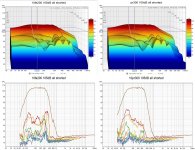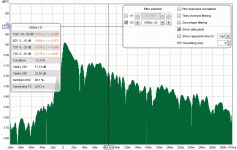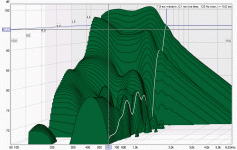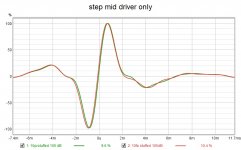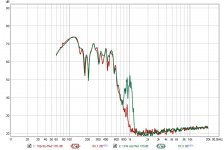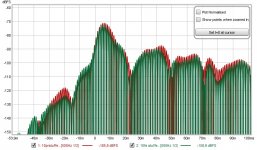The 10FE200 has a weaker motor and a lower moving mass, which implies a thinner cone (winding depths are very similar, although the wire thickness is unknown).
Under high-pressure loading, I'd expect the cone to flex a little, effectively soft-clipping the waveform in a symmetrical way. Symmetry implies odd-order harmonics, which are seen in the distortion charts - the 10FE200 has higher 3rd harmonic than the 10PR300.
There's another factor pointing in this general direction: soft cones tend to be very benign as they get towards the top of their operating range.
We can see that the more rigid the radiating surface, the higher-Q the resonances. This lends weight to the hypothesis that the 10PR300 simply has a more rigid cone, and, based on Mark's impressions of the sound, that makes it more suitable for high-pressure loading situations.
Chris
Thanks Chris, your post reflects where i've been leaning...that the weaker motor and lighter cone just aren't up to the compression ratio.
I want to do some higher spl testing with real music. I'm thinking smaart with its source independent measurement capability might show something on transients that pink and sine sweeps can't ....
....just spitballing...
Again thx to all for comments..
Here's some measurements i took where the two CD coax sections were shorted along with the undriven mid driver.
This was mainly just to eliminate any further potential source of resonances. It is amazing how much mid response changes when one on the mid drivers is left unshorted. Loopback time even moves considerably.
Anyway, below are waterfalls and THD plots taken at 105dB 1m.
I didn't bother with including mag, phase, or impulses, because they all look identical. (again, each driver had it's own FIR correction built.)
The only interesting thing i've noticed from shorting the CD, is how much the THD plot of the pr300 changed. It lost a big spike in 2nd at about 400Hz, whereas the fe200 was rather unaffected by shorting.
Checked this several times because it seemed weird....no clue why....
Here's some measurements i took where the two CD coax sections were shorted along with the undriven mid driver.
This was mainly just to eliminate any further potential source of resonances. It is amazing how much mid response changes when one on the mid drivers is left unshorted. Loopback time even moves considerably.
Anyway, below are waterfalls and THD plots taken at 105dB 1m.
I didn't bother with including mag, phase, or impulses, because they all look identical. (again, each driver had it's own FIR correction built.)
The only interesting thing i've noticed from shorting the CD, is how much the THD plot of the pr300 changed. It lost a big spike in 2nd at about 400Hz, whereas the fe200 was rather unaffected by shorting.
Checked this several times because it seemed weird....no clue why....
Attachments
I just noticed you said it only happens on transients. Could it be the port chuffing ? Maybe the difference in front chamber size causes one driver to be tuned higher than the other so it is not causing as much port velocity as the other ?
Again, just thinking of possible causes.....
Rob.
(you should hear the ports on my test box with ~200w going to them 😱 )
Again, just thinking of possible causes.....
Rob.
(you should hear the ports on my test box with ~200w going to them 😱 )
At least there are measurable differences... as some had noted, the biggest difference is at the start of the bandpass around 500-600 Hz.
So I've looked at a filtered IR to see if there were differences there:

and next looked at a waterfall plot after about 5 cycles at 630 Hz:

Clearly the 10PR is following what it's told to do a little better, while the 10FE struggles to keep up. Around 500 Hz that difference has become about 2.5 dB that the FE is lagging compared to the PR.
I see other differences as well, if I look at the signal before the peak (by filtering the IR), but that's 40 dB down and doubtful one could hear it.
I'd say the 10PR does exactly what it's told to do. The 10FE can't help itself and is struggling from the start (well, all relative because it still does a good job, just not as good as the other one).
Look at the filtered IR at 500 Hz and you'll see the 10PR has a nice rounded top while the 10FE seems thin in comparison.
So I've looked at a filtered IR to see if there were differences there:
and next looked at a waterfall plot after about 5 cycles at 630 Hz:
Clearly the 10PR is following what it's told to do a little better, while the 10FE struggles to keep up. Around 500 Hz that difference has become about 2.5 dB that the FE is lagging compared to the PR.
I see other differences as well, if I look at the signal before the peak (by filtering the IR), but that's 40 dB down and doubtful one could hear it.
I'd say the 10PR does exactly what it's told to do. The 10FE can't help itself and is struggling from the start (well, all relative because it still does a good job, just not as good as the other one).
Look at the filtered IR at 500 Hz and you'll see the 10PR has a nice rounded top while the 10FE seems thin in comparison.
Attachments
I just noticed you said it only happens on transients. Could it be the port chuffing ? Maybe the difference in front chamber size causes one driver to be tuned higher than the other so it is not causing as much port velocity as the other ?
Again, just thinking of possible causes.....
Rob.
(you should hear the ports on my test box with ~200w going to them 😱 )
Sorry Rob, didn't mean to say or give the impression it only happens on transients.
Any good bass or rythmn line that pulses can have it too.
I was just thinking music transients might make it easier to identify something via measurements.
If it were chuffing, i think i'd hear a difference at greater spl with either driver, which i can't say i do.
or that the pr300 would be the first to chuff with a stonger motor....???? (guessing)
Say yours chuffs like hell huh? eek for sure lol
What does the step response look like between the two?
Here you go... seems about as close as could be ???
Do you find much value in step? What do you look for other than the classic textbook slope ?
I haven't found step helps much yet, being too dominated by HF info, and xover rotations when above first order....
But then again, i've been pretty much confined to being a mag and phase junkie for reflection free speaker tuning, and then impulses when bringing room into play.
Attachments
At least there are measurable differences... as some had noted, the biggest difference is at the start of the bandpass around 500-600 Hz.
So I've looked at a filtered IR to see if there were differences there:
and next looked at a waterfall plot after about 5 cycles at 630 Hz:
Clearly the 10PR is following what it's told to do a little better, while the 10FE struggles to keep up. Around 500 Hz that difference has become about 2.5 dB that the FE is lagging compared to the PR.
I see other differences as well, if I look at the signal before the peak (by filtering the IR), but that's 40 dB down and doubtful one could hear it.
I'd say the 10PR does exactly what it's told to do. The 10FE can't help itself and is struggling from the start (well, all relative because it still does a good job, just not as good as the other one).
Look at the filtered IR at 500 Hz and you'll see the 10PR has a nice rounded top while the 10FE seems thin in comparison.
Nice wesayso, thx.
You certainly can glean more from peering into the waterfalls and filtered impulses than i can !
Practice makes perfect huh?
I guess a big part of the reason i can't discern ancillary measurements very well, is every time i get an idea about what might cause what, i just go alter the build and then measure mag and phase.
Impulse, step, waterfalls, spectogram, etc, all are there for conformation so far.
But it appears if i want to take measurements to a higher level i need to look at those harder...
Thx again...
I look for a right triangle indicative of good time alignment and phase alignment. But if you are running LR4 etc, it’s not going to look like that. It’s my thing with transient perfect speakers. If you are running DSP, there’s no reason why you can’t use a Harsch XO.
S. Harsch XO
Something resembling this for step response:
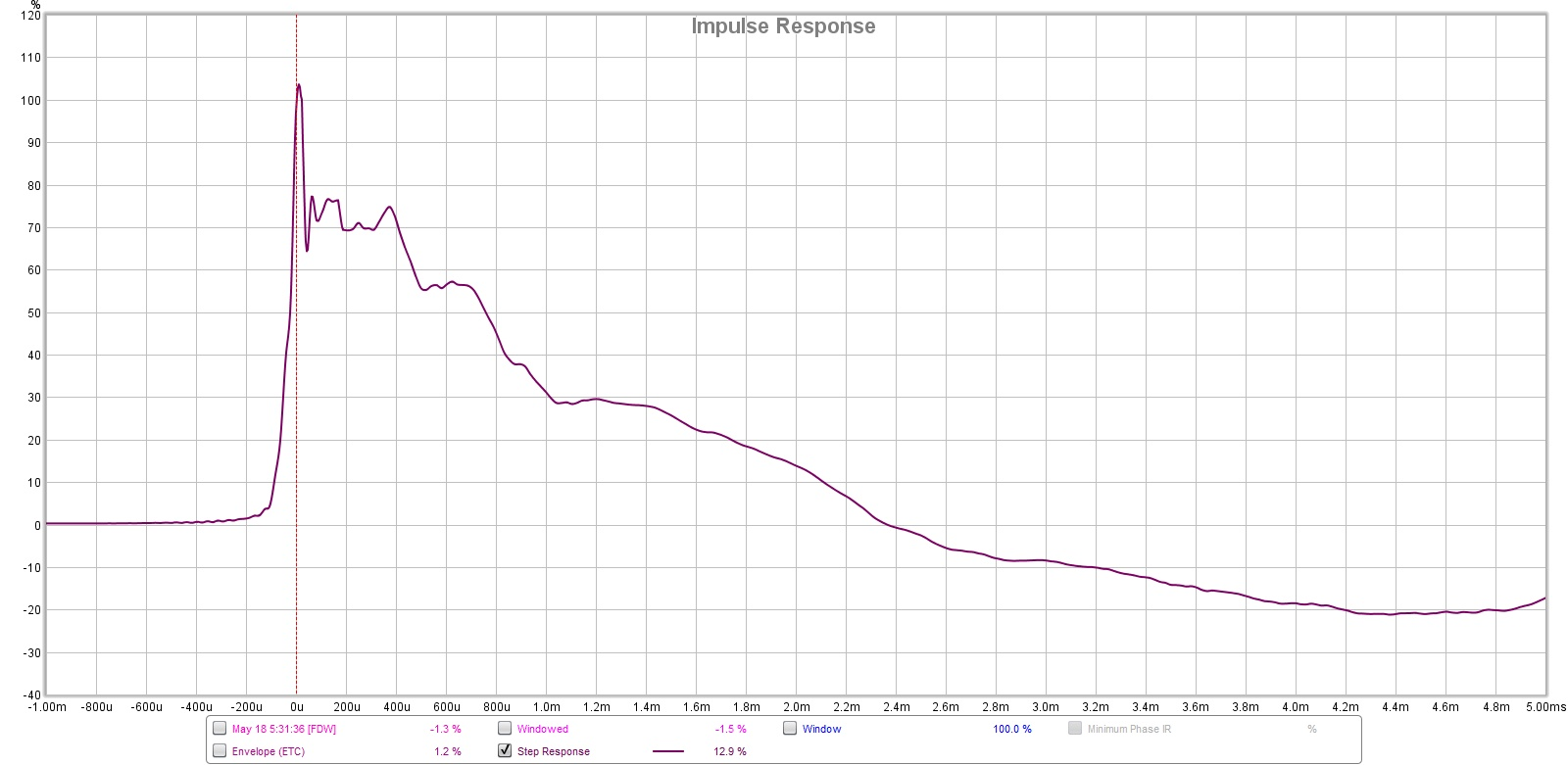
That was from a passive Harsch XO with my PTT6.5 and an RS28F in a waveguide.
S. Harsch XO
Something resembling this for step response:
That was from a passive Harsch XO with my PTT6.5 and an RS28F in a waveguide.
Last edited:
Say yours chuffs like hell huh? eek for sure lol
I'd expect it to 😀 I EQ'd to 50Hz to see what it would sound like 'with a bit of bass' and then maxxed out my 200w amp on the pair of lab12's.
I don't think 4x 2.5" holes can cope with that. (put my hand near the ports and the air movement was very high)
Maybe another reason as to why the originals are rear ported near 80Hz, keeps excursion down and cleans up the front ports output.
Cheers,
Rob.
Believe me, the total response of Mark100 is going to look a lot better than any Harsch XO you'll be able to whip up. What Mark showed us is a bandpass step of 2 single woofers.
I'm sure Mark will have an example of his total system STEP that blows an example like the above out of the water. Neither of those is going to tell us how it sounds. Nor does the STEP of the woofers tell us anything in this case. We need to dig a little deeper.
Below about 350 Hz both are performing quite similar. It is above 350 to just past 600 where there are notable differences. Even above that there are indications that one driver is more textbook like than the other.
For instance if we look at what happens before the peak:

(IR filtered before the peak to see any pré-signal, down far enough not to worry about it,
looking closely at the Spectogram/Wavelet shows this too)
See how the 10FE is showing a little pré-signal at 1 KHz? It's far enough down not to be audible, but probably an indication that it struggles a little more than the 10PR to keep the shape Mark wants them to confirm to. The higher H3 is also an indication of that.
I do value STEP response though, however not without looking at the other derived graphs a little closer to tell all of the story.
I'm sure Mark will have an example of his total system STEP that blows an example like the above out of the water. Neither of those is going to tell us how it sounds. Nor does the STEP of the woofers tell us anything in this case. We need to dig a little deeper.
Below about 350 Hz both are performing quite similar. It is above 350 to just past 600 where there are notable differences. Even above that there are indications that one driver is more textbook like than the other.
For instance if we look at what happens before the peak:
(IR filtered before the peak to see any pré-signal, down far enough not to worry about it,
looking closely at the Spectogram/Wavelet shows this too)
See how the 10FE is showing a little pré-signal at 1 KHz? It's far enough down not to be audible, but probably an indication that it struggles a little more than the 10PR to keep the shape Mark wants them to confirm to. The higher H3 is also an indication of that.
I do value STEP response though, however not without looking at the other derived graphs a little closer to tell all of the story.
Attachments
Last edited:
Ok, if it’s an all FIR convolution type speaker, sure - it’s going to have a perfect step response. I just wasn’t sure when I saw the down up wiggle how that could ever be right triangle once the tweeter and woofers were added.

What I have noticed sometimes is drivers have a characteristic sound from the material. For example, both the B80 and 10F/8424 are excellent flat measuring film range/mid range drivers. The paper B80 has a different sound than the fiberglass 10F. It may be the higher order harmonic distortions and their characteristic signature. Or how they decay in time.
My step response won’t compare well to an all DSP active 3 way but keep in mind that’s a passive 2 way with only 8 XO components.
What I have noticed sometimes is drivers have a characteristic sound from the material. For example, both the B80 and 10F/8424 are excellent flat measuring film range/mid range drivers. The paper B80 has a different sound than the fiberglass 10F. It may be the higher order harmonic distortions and their characteristic signature. Or how they decay in time.
My step response won’t compare well to an all DSP active 3 way but keep in mind that’s a passive 2 way with only 8 XO components.
Last edited:
Completely different ball game 😉, but at the SPL levels we see here it could never be a match. Did you notice these tests were done at 105 dB? 😱
It would be harder already to hear differences if that B80 and 10F were put trough Mark's EQ/FIR regime. I can't call those drivers flat if I compare them to these band passed woofers 🙂.
Looking at a STEP from a band passed woofer is never going to be pretty. The total band pass a speaker covers determines how that STEP response looks.
Even a room curve will mess with this look. The only valid comparison we could make could be whipped up with RePhase in no time. A band passed linear phase IR without any actual woofer messing it up. That would be the ideal, or close enough to it. Something I would use to check against to know what should be considered ideal behaviour and what parts are related to less than perfection from our drivers and/or environment.
Mark is well versed in tuning his speakers and indeed most of them show exemplary IR's, tuned to perfection. However differences between woofers most always show up.
I have a way harder time to explain the differences I hear between my two DAC's or the amplifiers I've heard personally. Even though I can't always find the reason will not mean there isn't a difference. At least with a wire change long ago I was able to come up with a measurable difference (lol).
Here's the filtered IR difference between the two DUT's at 500 Hz:

They were no doubt asked to do the same thing, but in reality don't act quite the same. We could simply conclude you get what you pay for in this upgrade. Not always true, perhaps, but in this case it seems to apply.
It would be harder already to hear differences if that B80 and 10F were put trough Mark's EQ/FIR regime. I can't call those drivers flat if I compare them to these band passed woofers 🙂.
Looking at a STEP from a band passed woofer is never going to be pretty. The total band pass a speaker covers determines how that STEP response looks.
Even a room curve will mess with this look. The only valid comparison we could make could be whipped up with RePhase in no time. A band passed linear phase IR without any actual woofer messing it up. That would be the ideal, or close enough to it. Something I would use to check against to know what should be considered ideal behaviour and what parts are related to less than perfection from our drivers and/or environment.
Mark is well versed in tuning his speakers and indeed most of them show exemplary IR's, tuned to perfection. However differences between woofers most always show up.
I have a way harder time to explain the differences I hear between my two DAC's or the amplifiers I've heard personally. Even though I can't always find the reason will not mean there isn't a difference. At least with a wire change long ago I was able to come up with a measurable difference (lol).
Here's the filtered IR difference between the two DUT's at 500 Hz:
They were no doubt asked to do the same thing, but in reality don't act quite the same. We could simply conclude you get what you pay for in this upgrade. Not always true, perhaps, but in this case it seems to apply.
Attachments
I have used the 12PR310 in a front loaded horn (4 of them). They are very sensitive and have a great tight sound when horn loaded. Definitely a different class of driver than the xFEyy series.
- Home
- Loudspeakers
- Multi-Way
- A case where measurements go ????
